History
From its first meeting at the home of Hirsch Sinzheimer on Oak Street in Buffalo in 1850, Temple Beth Zion (TBZ) grew into one of the oldest and largest Reform congregations in the nation. Originally an Orthodox congregation, TBZ reorganized as a Reform congregation in 1863.
In 1864, TBZ purchased its first building, a Methodist Episcopal Church on Niagara Street. After extensive redecorating, the synagogue was officially dedicated the following year, at a service at which both Rabbi Isaac N. Cohen and Rabbi Isaac M. Wise, the leader of the Reform Movement spoke. As was common, Rabbi Cohen's sermon was in German, while Rabbi Wise addressed the congregation in English.
Rabbi Samson Falk succeeded Rabbi Cohen and served as rabbi until 1886. The first Jewish clergyperson who was the product of a strictly secular western education, Rabbi Falk was particularly successful in the area of community relations, strengthening ties and understanding between Jews and Christians. Under Rabbi Falk, the congregation joined the Union of American Hebrew Congregations in 1873.
The Niagara Street Temple was sold in the mid-1880's, and the congregation, under the leadership of Rabbi Israel Aaron, purchased land at 599 Delaware Avenue. With the charge to create a house of worship that was distinguishable from any area church, Architect Edward A. Kent created an instant landmark from the day it was dedicated in 1890. With its exotic Byzantine architecture, Medina brown stone walls and huge, copper covered half-sphere dome, the new Temple Beth Zion was immensely impressive. In addition to the Temple's 112 member families, over 1,000 guests filled the sanctuary of the Temple for the dedication.
Under the leadership of Rabbi Louis J. Kopald, TBZ expanded its facilities. The congregation also organized its first men’s club and Young People’s Society (the Ladies Temple Society, later renamed Sisterhood, had been founded in 1891). Illness forced Rabbi Kopald to retire in 1924, leaving the congregation without a Rabbi until 1926, when Rabbi Joseph L. Fink began his illustrious career.
In addition to the respect and admiration Rabbi Fink engendered as TBZ’s spiritual leader, he was regarded as an outstanding spokesman on all issues affecting the community. A gifted and forceful speaker, Rabbi Fink could be counted on to deliver keen insight to the everyday problems of all people, and he never backed away from controversy. Well-known to both Presidents Roosevelt and Truman, his voice was familiar to thousands who listened to his Humanitarian Hour radio program which ran for 26 years.
Under the leadership of Dr. Fink and Herman Wile, who served the congregation for over 50 years, TBZ grew substantially.
In 1958 Rabbi Fink retired and Rabbi Martin L. Goldberg, Rabbi Fink's associate since 1954, became Senior Rabbi. That year, the congregation dedicated a second facility in suburban Amherst, primarily to meet the growing classroom needs of its members and their children.
In 1961, a fire destroyed the Delaware Avenue temple. Without a sanctuary for the first time since 1890, Rabbi Goldberg continued to hold services; in churches, the Jewish Community Center and, for the High Holy Days, Kleinhans Music Hall. Agencies and businesses volunteered their facilities for religious school classes.
In April 1967, our new building, at 805 Delaware, was dedicated. Designed by architect Max Abramovitz, TBZ became one of Buffalo's prominent landmarks. The 1,000 seat sanctuary consists of scalloped walls, 60 foot ceilings and two 30 foot high commandment tablets which, along with two magnificent stained glass windows, were created by artist Ben Shahn. The 48 rank organ is by the Casavant Freres Company. In addition to clergy studies, the building houses the Rabbi Joseph L. Fink Auditorium, 200 seat Sisterhood Chapel, and the Cofeld Judaic Museum which proudly displays many rare and beautiful artifacts. Each year, thousands of people tour the building.
During Rabbi Goldberg's tenure, TBZ’s membership reached its highest level ever at approximately 1,700 households and the congregation established the Rabbi Martin L. Goldberg Endowment Fund. Rabbi Goldberg stepped down in 1994 and assumed the title of Rabbi Emeritus. That year, Rabbi Ronne Friedman was installed as the Temple's eighth Rabbi.
Rabbi Friedman began a period of rebirth for TBZ. During his tenure, membership began to grow again, and the programming and finances were greatly enhanced.
To better serve younger families who primarily reside in the northern suburbs, an ambitious renovation and expansion program for the Amherst facility took place. The Sweet Home Road building was rededicated in November 1998 as the Aaron and Bertha Broder Center for Jewish Education. The Broder Center combines a beautiful, modernized school and meeting facility with the principal offices of the clergy and administrative staff.
Rabbi Friedman left TBZ in 1999 and was succeeded by Rabbi Harry Rosenfeld who served until 2011. During Rabbi Rosenfeld’s tenure, TBZ established its multi-faith social action program (Mitzvah Day), an active Caring Community, and the Rabbi Joseph and Janice Fink Legacy Society. The Delaware Avenue building, our spiritual and cultural home, was restored and refurbished in 2005. Further renovations to the Sisterhood Chapel were completed in 2010.
TBZ is one of 13 synagogues featured in films exploring the post-World War II role of synagogues in the United States created for the new National Museum of American Jewish History in Philadelphia. “We chose Temple Beth Zion because it represents an iconic marriage of modernism and religious tradition,” said Dr. Josh Perelman, the Museum’s historian and deputy director of programming.
Rabbi Gary Pokras served as the congregation's Associate Rabbi from 1999-2002, and then served as TBZ’s tenth senior Rabbi from 2011 - 2016. Rabbi Jonathan Freirich joined the Clergy team in 2016 and served until the end of 2020.
Rabbi Sharon Sobel served as Interim Senior Rabbi, January 2021-July 2022.
Today, Senior Rabbi Brent Gutmann and Cantor Lewis-Friedman make up the Clergy team.
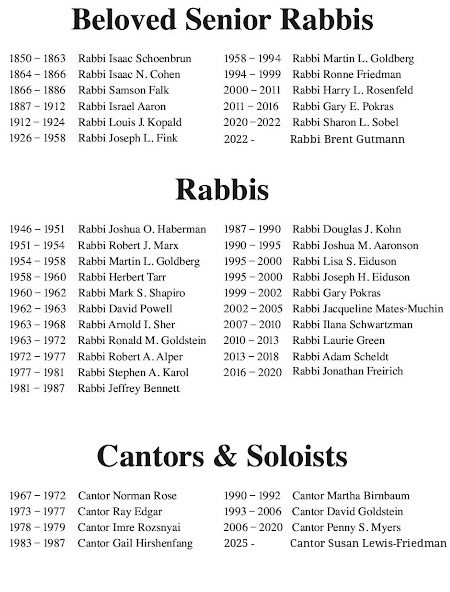
1955 Chuckwagon Jamboree
On June 5, 1955, the Ball family hosted a Chuckwagon Jamboree at their farm, named Hertina Farms, in Clarence, NY. At the event, an amateur film was made by members of Temple Beth Zion to document the first and the largest all-congregation outing in the Temple's history. To view the film, click here and enjoy a fun piece of TBZ's history.
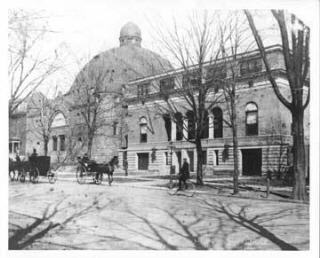
The photo above shows the original Temple Beth Zion building which was built at 599 Delaware Avenue in 1890. This beautiful Byzantine-style landmark was tragically lost to a fire in 1961.
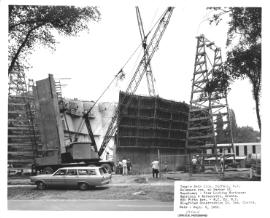
Construction began at a new site at 805 Delaware Avenue in 1965. This is a northeast view of the construction of the Sanctuary .
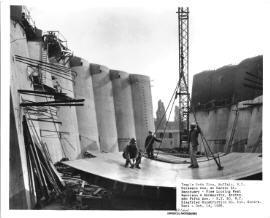 This west view shows the opening between the walls that will eventually be filled by one of the two magnificient stained glass windows created by artist Ben Shahn. This photo was taken on October 14, 1965.
This west view shows the opening between the walls that will eventually be filled by one of the two magnificient stained glass windows created by artist Ben Shahn. This photo was taken on October 14, 1965.
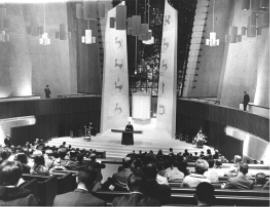
On April 21, 1967, the Sanctuary at 805 Delaware was filled for the dedication of Temple Beth Zion's new spiritual home.
"Our Father in heaven, so establish this sanctuary, dedicated to Thy holy name, that the worship offered within its walls may be worthy of Thy greatness and Thy love; and that this house may be a house of prayer for all peoples." - Union Prayer Book
Below is a portion of silent, black and white footage from the Spring 1966 Confirmation Service. The service was held in the Rabbi Joseph Fink Auditorium at 805 Delaware Avenue, Buffalo.
Thank you to Bruce and Nancy Sanders for the footage.

